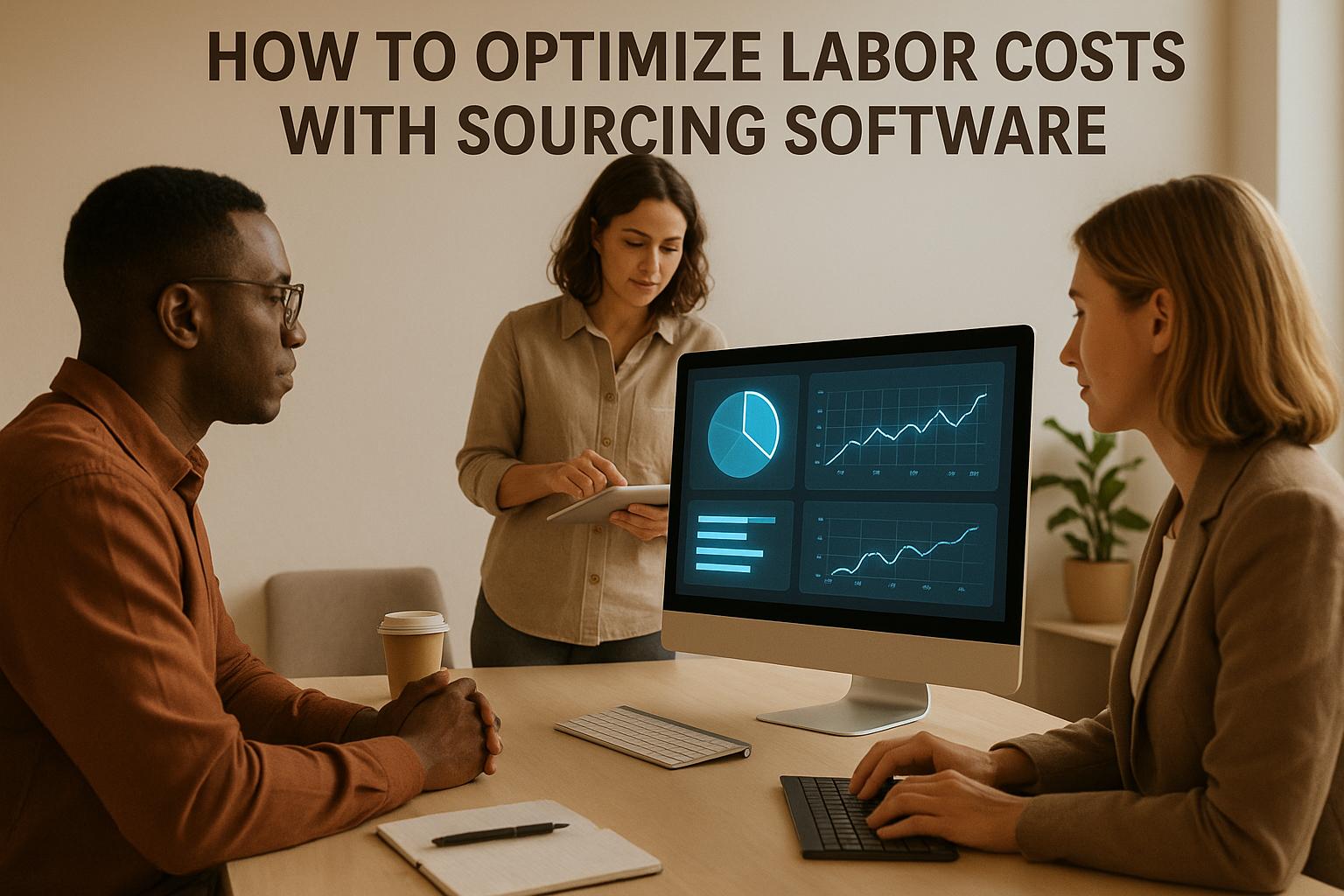
Optimizing labor costs is about reducing expenses while maintaining efficiency and quality. Sourcing software simplifies this process by automating tasks, analyzing costs, and improving supplier management. Here’s how it helps:
- Detailed Cost Analysis: Breaks down labor costs (wages, overtime, indirect expenses) to identify savings opportunities.
- Supplier Performance Tracking: Monitors delivery times, quality, and costs to pinpoint inefficiencies.
- Scenario Modeling: Compares cost-saving options like automation or supplier changes.
- Integration with ERP/CRM Systems: Provides a unified view of labor costs across operations.
- Predictive Analytics: Anticipates future cost challenges and optimizes staffing needs.
For example, companies using tools like QSTRAT have cut overtime costs by 30% and streamlined labor management. Sourcing software not only reduces costs but also ensures continuous improvement through real-time monitoring and data-driven decisions.
Labor Cost Optimization Using Data Analysis
Key Features of Sourcing Software for Labor Cost Reduction
Modern sourcing software has reshaped how businesses manage labor costs, offering tools that streamline analysis, tracking, and cost-cutting across supplier networks. These features work together to provide a clear and actionable understanding of labor expenses, helping businesses implement smarter cost-saving strategies.
Automated Cost Analysis and Breakdown
Gone are the days of relying on vague, lump-sum quotes. Automated cost analysis breaks down labor expenses into detailed components, such as raw materials, packaging, and transportation. This level of detail helps businesses see exactly where their money is going and uncover areas to cut costs.
Take the Strategic Sourcing team at Carl Zeiss, for example. Using QSTRAT Sourcing, they collect over 50 separate data elements from suppliers during bidding for new product development and engineering changes. This data provides deep insights into supplier labor cost structures, which are critical as production scales.
Advanced sourcing platforms go a step further by incorporating AI. These systems can flag unusual quotes or highlight potential savings within specific cost areas, including labor. They also support scenario analysis, allowing businesses to model and compare different labor cost structures. This feature is especially useful when negotiating contracts or evaluating new suppliers.
Supplier Performance Management
Managing supplier performance is another area where sourcing software excels. By consolidating vendor data into a single dashboard, businesses can track metrics like delivery times, quality ratings, and cost per unit – all of which influence labor efficiency. This centralized view makes it easier to identify which suppliers are driving up costs and which are delivering value.
Real-time dashboards provide instant visibility into supplier labor efficiency, enabling quick, informed decisions about vendor relationships. If a supplier consistently has higher labor costs, businesses can negotiate better terms or switch to a more efficient alternative. Additionally, supplier management tools streamline onboarding, automate rankings, and even include ESG evaluations, ensuring the supplier network operates efficiently while meeting broader business goals.
These tools also encourage suppliers to improve. By sharing performance data, businesses can promote better labor practices and support quality initiatives, creating a win-win for both parties.
Integration with ERP and CRM Systems
The ability to integrate seamlessly with ERP and CRM systems is a game-changer. This connectivity links sourcing, costing, quoting, and production processes, creating a unified view of labor costs across the entire operation. Real-time data exchange ensures that information flows smoothly, from initial sourcing decisions to final production costs.
This integration allows businesses to compare projected labor costs with actual expenses, helping them identify discrepancies and refine cost estimation methods. It also supports agile decision-making. For instance, procurement teams can quickly adjust to changes in the market, supplier performance issues, or shifts in production demands, ensuring labor costs remain optimized.
Collaboration also improves when everyone works from the same data. Procurement, finance, and operations teams can align their decisions more effectively, reducing miscommunication and ensuring labor cost strategies fit within broader business goals. This unified approach is especially valuable for companies managing complex supplier networks across multiple locations or product lines. Together, these integrated features set the stage for the step-by-step cost optimization guide that follows.
Step-by-Step Guide to Optimizing Labor Costs with Sourcing Software
Reducing labor costs doesn’t have to come at the expense of quality or compliance. By systematically collecting data, modeling scenarios, and collaborating with suppliers, you can turn raw cost data into actionable insights that drive efficiency and savings.
Collect and Analyze Labor Cost Data
The first step in optimizing labor costs is gathering detailed and accurate data. Start by importing supplier labor information, such as hourly wages, overtime rates, shift differentials, total hours worked, and indirect expenses. For U.S.-based manufacturers, ensure the data adheres to proper formatting, including dollar symbols ($), MM/DD/YYYY dates, and decimal separators (e.g., $1,234.56).
One example of this approach in action comes from a leading manufacturer that used QSTRAT Sourcing during both New Product Development and Engineering Change processes. By integrating detailed supplier data, they streamlined trial runs and scaled up to full production volumes seamlessly.
Your sourcing software should help by automatically aggregating and visualizing labor cost data, identifying anomalies like excessive overtime or inflated indirect expenses. Built-in analytics can compare labor costs across suppliers, highlight trends, and generate reports that pinpoint inefficiencies, such as redundant tasks or process bottlenecks. Automated alerts can also flag compliance risks, like exceeding legal overtime limits or failing to meet minimum wage standards.
Data can be sourced from existing costing systems like QLM Costing, spreadsheets, prior sourcing events, or even manual entry. The key is consistency – capturing both direct and indirect labor costs across your supplier network ensures a clear and actionable view of your labor expenses.
Once you’ve gathered and analyzed the data, the next step is to model potential savings scenarios.
Create Cost Scenarios
With detailed labor cost data in hand, use your sourcing software’s scenario modeling tools to explore different cost-saving opportunities. Adjust variables like wage rates, shift schedules, and automation levels to compare labor costs across suppliers or production setups. This allows you to quantify savings before making any major decisions.
For instance, BAE Systems leveraged QSTRAT Sourcing to compare cost components among suppliers and drive quality improvements at the same time. Scenario modeling can help you evaluate options like increasing automation, redistributing workloads across shifts, or consolidating suppliers. Each scenario should include metrics like labor cost per unit, total hours required, and any compliance considerations.
AI tools can further streamline this process by flagging out-of-range quotes or inefficient bids. Decision support tools in your software can provide instant access to supplier responses and enable side-by-side comparisons of bids and scenarios. Track KPIs such as labor cost per unit, overtime hours, absenteeism rates, and supplier efficiency scores to measure the success of each scenario. After implementing a scenario, compare the projected costs with actual results to refine future strategies.
Work with Suppliers to Reduce Costs
Once you’ve identified potential savings, the next step is engaging suppliers to collaborate on cost reduction efforts. By working together, cost optimization becomes a shared goal. Use your sourcing software’s real-time communication and data-sharing features to set clear cost reduction targets, share labor cost data, and address inefficiencies as a team.
A U.S. automotive manufacturer showcased this collaborative approach by utilizing QSTRAT’s sourcing platform. They automated supplier quoting and labor cost analysis, achieving substantial cost savings. The platform’s collaboration tools enabled joint process improvements and continuous cost monitoring.
Your sourcing software should facilitate structured supplier meetings, track action items, and monitor progress toward agreed goals. Features like shared dashboards, automated quoting, and performance tracking foster transparency and encourage suppliers to propose initiatives like process standardization or automation. Tools such as supplier scorecards and feedback loops can help maintain accountability and drive ongoing improvements.
QSTRAT simplifies supplier engagement by combining quoting, performance management, and cost analysis into a single cloud-based platform. This approach supports industries like automotive and aerospace by promoting better labor practices and quality improvements that benefit both parties.
Regularly review labor efficiency metrics with your suppliers. Focus on identifying bottlenecks, eliminating redundant processes, or finding opportunities for automation that cut labor requirements without sacrificing quality. Document agreed-upon improvements and use your sourcing software to track progress and measure results against established benchmarks.
sbb-itb-827f251
Monitoring and Continuous Improvement
Once you’ve taken steps to optimize labor costs, the journey doesn’t end there. Keeping those improvements intact requires consistent monitoring and a commitment to refining processes over time. Labor cost optimization isn’t a one-and-done task – it’s an ongoing effort. Without regular oversight, savings can slip away due to process inefficiencies or changing demand. Companies that use AI-driven labor optimization tools have seen a 30% reduction in overtime costs, along with noticeable boosts in operational efficiency, thanks to sustained monitoring.
The sourcing software that helped you achieve cost savings initially can now play a pivotal role in driving continuous improvement. By automating data collection and analysis, it ensures you have the visibility needed to track progress, identify potential problems, and adjust your labor cost strategies as needed. The key is creating systematic processes that turn raw data into actionable insights.
Automated Reporting and Trend Analysis
Automated reporting tools take the hassle out of tracking labor cost performance. These systems gather data from various sources – like supplier invoices, production schedules, overtime logs, and performance metrics – and transform it into real-time dashboards and scheduled reports. These reports highlight cost drivers, savings achieved, and any deviations from your set targets.
To get the most out of your sourcing software, configure it to monitor key labor cost metrics, such as:
- Total labor spend
- Labor cost per unit
- Overtime hours
- Absenteeism rates
- Productivity per employee
- Cost variances by department or shift
Tracking these metrics helps you identify inefficiencies, assess the impact of process changes, and set realistic goals for improvement. For U.S. manufacturers, ensure reports are formatted correctly – using dollar symbols ($), MM/DD/YYYY dates, and proper decimal separators (e.g., $1,234.56).
Platforms like QSTRAT provide advanced tools for supplier performance tracking and integrate seamlessly with ERP and CRM systems. This allows for comprehensive labor cost analytics, comparing projected costs with actual expenses. When discrepancies arise, the system flags them so you can take corrective action quickly.
Visual trend analysis tools, such as automated charts, make it easy to spot seasonal fluctuations, shifts in supplier performance, and the results of process improvements. These visual aids are especially useful for budget planning and presenting data to senior management. Regular benchmarking against industry standards and internal goals, combined with automated alerts for cost spikes or overtime surges, ensures your strategies stay on track and emerging issues are addressed immediately.
Improve Labor Cost Strategies with Predictive Analytics
Predictive analytics takes your labor cost management to the next level by turning historical and real-time data into future-focused insights. Instead of reacting to cost increases after they happen, these tools help you anticipate challenges, test different cost-saving strategies, and make proactive adjustments.
Scenario modeling within your sourcing software can simulate how changes – like adjusting shift patterns, increasing automation, or renegotiating supplier terms – might impact labor costs. For example, you could model the financial effects of adding a third shift, automating specific tasks, or consolidating work with fewer suppliers. Each scenario provides clear, data-backed projections to guide your decision-making.
AI-powered scheduling and sourcing tools also optimize staffing by aligning it with demand. These systems analyze demand trends, supplier capacity, and past performance to recommend the most efficient labor allocation strategies. They can even adapt in real time to changes in production needs, helping to minimize unnecessary labor expenses.
QSTRAT’s predictive analytics features go a step further by examining complex patterns across supplier networks. The platform identifies the most efficient sourcing strategies, flags out-of-range quotes, and highlights inefficient bids. Its decision-support tools allow side-by-side comparisons, making it easier to choose the best course of action.
Use predictive analytics to uncover seasonal trends, foresee capacity bottlenecks, and plan for workforce shifts. By analyzing patterns in your labor cost data, you can predict when overtime might spike, identify top-performing suppliers under specific conditions, and determine where automation investments will deliver the greatest benefits. This forward-thinking approach helps you stay ahead of potential issues and manage costs more effectively.
Review predictive insights on a monthly or quarterly basis to fine-tune your labor strategies as your business evolves.
Conclusion: The Role of Sourcing Software in Labor Cost Optimization
Optimizing labor costs isn’t just about cutting expenses – it’s about using smart, data-driven processes to achieve measurable results while maintaining high standards. This guide has shown how sourcing software shifts labor cost management from reactive choices to proactive, strategic planning.
The results are clear. Companies using advanced sourcing tools experience direct labor savings by automating tasks that were previously manual. For instance, QSTRAT streamlines operations with automated requisitions, notifications, and approval workflows, significantly reducing the need for manual effort. By eliminating manual data entry for supplier submissions, these tools free up valuable time across departments.
QSTRAT’s integrated platform takes it a step further by enabling informed decision-making. It allows businesses to compare costs across labor, raw materials, and transportation. A great example is BAE Systems, which leveraged QSTRAT to manage both internal and external labor expenses while maintaining a focus on quality. The platform’s ability to validate supplier responses and minimize administrative tasks translates directly to fewer labor hours spent on repetitive processes.
Beyond immediate efficiencies, sourcing software paves the way for continuous improvement. With features like predictive analytics and real-time monitoring, these systems ensure that labor cost savings are not only achieved but also sustained and enhanced over time.
As highlighted throughout this guide, sourcing software does more than just reduce costs through automation. It provides a foundation for long-term strategic refinement. For U.S. manufacturers grappling with rising labor costs and fierce competition, adopting sourcing software isn’t just a tech upgrade – it’s a game-changing investment. It transforms labor cost management from a reactive challenge into a proactive strategy, giving companies a competitive edge. Those who adopt these tools now are positioning themselves as leaders in operational efficiency for the future.
FAQs
How can sourcing software help lower overtime costs without reducing productivity?
Sourcing software is a game-changer when it comes to cutting overtime costs. By streamlining processes and enabling smarter resource allocation, it helps your team work more efficiently. Tasks like supplier quoting and performance tracking are automated, which reduces delays and allows your team to focus on what truly matters – high-priority activities. The result? Less need for those costly extra hours.
Take tools like QSTRAT, for example. They offer powerful data insights that spotlight cost-saving opportunities and improve collaboration with suppliers. This means you can keep operations running smoothly while keeping labor expenses in check.
How does predictive analytics help identify and address future labor cost challenges?
Predictive analytics uses data to anticipate labor cost trends and challenges, giving businesses the chance to act before problems arise. By examining historical data, market trends, and workforce metrics, it can reveal patterns like increasing overtime expenses, changes in supplier pricing, or inefficiencies in how resources are allocated.
This method allows companies to fine-tune their strategies, work more efficiently with suppliers, and introduce cost-saving measures early on. When paired with sourcing software, predictive analytics delivers actionable insights that help businesses make smarter, data-driven decisions to better manage labor costs.
How can businesses integrate sourcing software with their ERP and CRM systems to effectively manage labor costs?
Integrating sourcing software with your ERP and CRM systems is all about building a smooth, interconnected workflow. When these platforms work together, data moves effortlessly between them, leading to precise cost analysis and smarter decisions.
With QSTRAT, this integration becomes much simpler. It brings sourcing, quoting, costing, and supplier management under one roof. Plus, its ability to connect with ERP and CRM systems helps cut down on manual tasks, streamline processes, and save on labor costs by leveraging automation and data insights effectively.



